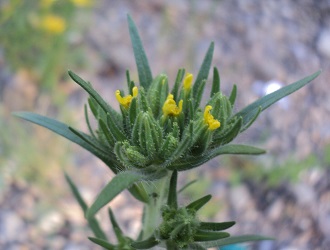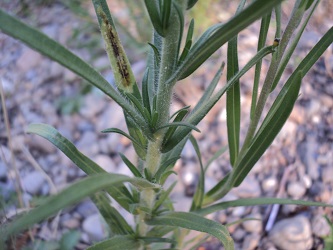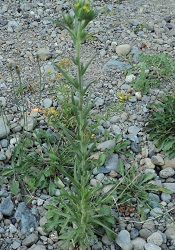|
|
|
|
|
|
| Practical ecological knowledge for the temperate reader. |
Tarweed - Madia Sp.
Family: Aster
[E-flora]

Madia glomerata |

Madia glomerata |

Madia glomerata |

Madia glomerata |
"Annual, 0.5–25 dm. Stem: erect. Leaf: proximal opposite, often in rosettes, distal alternate, sessile; blades lanceolate or oblong-linear to linear, generally entire, seldom toothed, coarse- to soft-hairy, generally also glandular. Inflorescence: heads generally radiate, occasionally obscurely so (discoid), in flat-topped or panicle-, raceme-, or spike-like clusters; involucre 1–10+ mm diam, generally ± spheric to ovoid or urn-shaped; phyllaries in 1 series, lance-linear to oblanceolate, each mostly or wholly enfolding a subtended ray ovary, falling with fruit, coarse-hairy, generally glandular; receptacle flat to convex, glabrous or minutely bristly; paleae in 1 series between ray and disk flowers, ± fused or free, phyllary-like but more scarious, generally persistent (falling readily in Madia radiata). Ray flower: (0)1–22; corolla generally ± yellow, ray sometimes maroon or ± purple adaxially, proximally, or throughout. Disk flower: 1–80+, bisexual or staminate; corolla generally ± yellow, sometimes ± purple, tube <= throat, lobes deltate; anther ± dark purple or yellow to ± brown, tip oblong to ± ovate or ± semicircular; style glabrous proximal to branches, tips narrowly triangular, hairy. Fruit: ray fruit generally compressed side-to-side, generally ± 3-angled (rarely cylindric), ± club-shaped, often arched, glabrous, tip occasionally beaked, pappus 0; disk fruit 0 or similar to ray fruit, sometimes obovoid, often ± straight, tip not beaked, pappus 0."
"10 species: western North America, southern South America; introduced elsewhere. (Native Chilean name) [Baldwin & Strother 2006 FNANM 21:303–308] Generally self-fertile (except Madia elegans and Madia radiata). Other taxa in TJM (1993) moved to Anisocarpus, Harmonia, Hemizonella, Jensia, Kyhosia.
Unabridged disk flower: anther base acute to cordate or sagittate. " [Jepson]
Local Species;
- Madia exigua - Little tarweed [E-flora][PCBC][TSFTK]
- Madia glomerata - Clustered tarweed [E-flora][PCBC]
- Madia gracilis - Slender tarweed [E-flora]
- Madia sativa - Chilean tarweed [E-flora][PCBC]
Food Use
"Kalapuya people ate
tarweed seeds (Madia spp.)..." [Apostol RPNW]
"... many California Indian tribes echoed the practice of the
indigenous peoples of Chile by eating the oily seeds of species in the genus
Madia and caring for populations of the plants." [Anderson TTW]
Cultivation
"The Indians used to burn to increase the seed crops such as tarweeds [Madia sp.]" [Anderson TTW]
Madia exigua - Little tarweed
- General:
"Aromatic annual herb from a slender taproot; stems erect, simple, branched above, stiff-hairy, 5-30 cm tall." [IFBC-E-flora]
- Leaves: "Basal leaves lacking; stem leaves alternate, simple, entire, linear, 1-4 cm long, 1-2 mm wide, glandular, stiff-hairy." [IFBC-E-flora]
- Flowers: "Heads with ray and disk flowers, solitary at the ends of branches in an open, flat-topped inflorescence; involucres depressed-globose, 2.5-4.5 mm tall; involucral bracts linear dorsally, crescent shaped laterally, 4-8, glandular; ray flowers yellow, 4-8, 1 mm long; disk flower yellow, receptacular bracts united around the fertile disk flower." [IFBC-E-flora]
- Fruits:" Achenes compressed, 1.8-2.8 mm long, dark brown or black; disk achenes sterile; pappus lacking." [IFBC-E-flora]
- Habitat / Range: "Dry grasslands, roadsides and disturbed areas in the lowland, steppe and lower montane zones; frequent in extreme S BC; S to NV, CA and MX." [IFBC-E-flora]
- Status: Native [E-flora]
Clustered Tarweed - Madia glomerata
- General: "Aromatic annual herb from a taproot; stems erect, solitary, simple or with a few ascending branches, long- to stiff-hairy, yellow stalked-glandular above, 10-95 cm tall." [IFBC-E-flora]
- Leaves: "Basal leaves lacking; stem leaves often with fascicles in their axils, alternate, simple, entire, linear or lance-linear, 2-9 cm long, 1-7 mm wide, glandular, stiff-hairy." [IFBC-E-flora]
- Flowers: "Heads with ray and disk flowers, glomerate in 1-many small clusters or in a more open inflorescence; involucres spindle-shaped, 6-9 mm tall; involucral bracts broadly lanceolate, glandular; ray flowers 1-3, about 2 mm long, sometimes lacking from some heads, greenish-yellow to purplish, 1.5-2.5 mm long; disk flowers 1-10." [IFBC-E-flora]
- Fruits: "Achenes 5-nerved, compressed, glabrous, black, 4-6 mm long; pappus lacking." [IFBC-E-flora]
- Habitat / Range: "Moist to dry roadsides, meadows, open slopes and forest openings in the lowland and montane zones; infrequent, scattered throughout S BC; E to SK and S to CO, AZ and CA." [IFBC-E-flora]
- Status: Native [E-flora]
"Madia-Anisocarpus-Hemizonella-Kyhosia Complex[;]
All the species in this complex in our region have long been assigned to Madia. Not all botanists would argue
that four genera, three of them with a single species each in our region, are needed." [Kozloff PWO]
Edible Uses
- Seed
- Raw or cooked.[257] Rich in oil, it can be ground into a powder and eaten dry.[61,105,161] [PFAF] M. glomerata and M. Sativa; "The seeds may be eaten
raw, roasted, dried, or ground into meal. When
scalded the seeds yield a good, nutritious oil" [Kirk WEP]
Other Uses
- Incense
- The dried herb has been burnt as an incense.[257] [PFAF] "The Crow of North America burned dried herbs for incense purposes during certain ceremonies (Blankinship 1905)." [UAPDS]
Medicinal Use
- Leaves & Stems
- An infusion of the leaves and stems has been used as a herb bath in the treatment of venereal disease.[257] [PFAF]
Madia gracilis - Slender tarweed
- General: "Aromatic annual herb from a tap root; stems erect, simple, usually branched, roughly hairy becoming glandular upwards, 10-100 cm tall." [IFBC-E-flora]
- Leaves: "Basal leaves lacking; stem leaves alternate, linear to lance-linear, 2-11 cm long, 1-10 mm wide, stiff-hairy and often densely glandular upwards." [IFBC-E-flora]
- Flowers: "Heads with ray and disk flowers, numerous in an elongate inflorescence; involucres urn-shaped, 6-11 mm tall; involucral bracts linear dorsally, crescent-shaped laterally, glandular; ray flowers yellow, 3-9, 1.5-2 mm long; disk flowers 13-15, fertile, with black anthers." [IFBC-E-flora]
- Fruits: "Achenes flattened, hairless, often mottled, 2.8-5 mm long; pappus lacking." [IFBC-E-flora]
- Habitat / Range: "Dry roadsides, open slopes and forest openings in the lowland, steppe and montane zones; infrequent in extreme S BC; S to UT, NV, CA and MX, disjunct in Chile." [IFBC-E-flora]
- Status: "Native [E-flora]
Chilean Tarweed - Madia sativa
- General: "Aromatic annual herb from a taproot; stems erect, simple, often branched above, glandular, 0.2-1.0 m tall." [IFBC-E-flora]
- Leaves: "Basal leaves lacking; stem leaves often with clusters of smaller leaves in their axils, alternate, linear or linear-oblong, entire or slightly toothed, unstalked, glandular, 3-18 cm long, 3-12 mm wide; lower stem leaves crowded, soon deciduous." [IFBC-E-flora]
- Flowers: "Heads with ray and disk flowers, numerous in an elongate inflorescence; involucres egg-shaped or broadly urn-shaped, 6-12 mm tall; involucral bracts rounded on the back, glandular; ray flowers yellow, 8-13, 3-7 mm long; disk flowers yellow, 11-14, fertile." [IFBC-E-flora]
- Fruits: "Ray achenes flattened, 2.5-5 mm, glabrous, sometimes mottled, disk achenes sometimes 1-nerved; pappus lacking." [IFBC-E-flora]
- Status: Exotic [E-flora]
Habitat / Range
"Dry roadsides and disturbed areas in the lowland and lower montane zones; infrequent in S BC, possibly introduced; native range from N WA to CA, disjunct in Chile." [IFBC-E-flora]
Edible Uses
- Seeds
- The seeds are sometimes used for pinole. Seeds of some of our native tarweeds could probably serve that purpose. [EWP]
- Raw or cooked[257]. Although quite small, the seed was a staple food for some native North American Indian tribes[257]. Rich in oil, it can be roasted then ground into a powder and eaten dry, mixed with water, or combined with cereal flours[94, 94, 183, 257]. The seed was also used as piñole[257].[PFAF]
- The seed contains about 41% of a sweet edible oil, about 28% can be extracted from the seed in an oil press[2, 46, 61]. Of a high quality, it can be used as a substitute for olive oil[2, 183]. The oil does not solidify until the temperature drops to -11°c[95]. [PFAF]
- "Some Northwest Coast Indians ate the
seeds (Haskin, 1934) and the leaves were
used as a tonic for rheumatism (Sweet,
1962)." [Turner&Bell1]
Other Uses
- Oil
- The seed is rich in an oil which is a good substitute for olive oil. A good lubricant, the oil is also used in soap making[94, 95]. [PFAF]
"The origin of this under-exploited oilplant is
the Southern Cordillere of Chile and Argentina. It seems to be the only South American species of the 20 Madi taxa. It is easily
recognized by its aromatic scent, caused by
a dense cover of oil glands (Kunkel 1984).
Araucanians developed in this region, where
no other vegetable fat sources exist, a humble oilplant. The Chilenean botanist Molina
(1782) called the attention of naturalists in
Europa to this curious Araucanian cultivar,
describing its oil as "identical to the best
olive oil". Consequently the plant was introduced to France, where it was cultivated in
the 19th century. The cultivation was interrupted on account of difficulties in harvesting the shattering achaenes. During the last
World War and due to the great shortage of
edible oil in Germany, Briicher and Fischer
(Briicher 1977) undertook selections in earlier hybrid populations with considerable success. They combined a better consistency of
ripe flower capitulae ("closed heads") with
non-shattering achaenae, and a low content
of viscocity and glandular trichomes, on
stems and leaves, with considerably improved oil content and larger seeds" [Brucher UPNO]
"This plant [M. sativa] is cultivated in Chile,
France, Germany and Italy for the sake of the limpid and sweet oil
which is expressed from its seeds. This oil is used as a substitute for
olive oil. The seeds yield about 41 per cent to analysis and from 26 to
28 per cent to the oil-press, according to Boussingault, whose
experiment in 1840 gave 635 pounds of oil and 1706 pounds of oil
cake per acre." [Sturtevant EPW]
Cultivation
"The plant is easily cultivated, requiring management
similar to seed clover, but, owing to the glutinous nature of the stems
and stalks, the seeds require to be threshed and sown as soon as the
crop is cut, otherwise fermentation injures them." [Sturtevant EPW]
Phytochemicals
"Madia is a genus of 18 species, primarily western North American in distribution, but also represented in Chile. Madia sativa, the Chilean
species now naturalized in California, was examined for flavonoids by Bohm
et aI. (1992) who reported 5,4'-dihydroxy-7-methoxydihydroflavonol
(dihydrorhamnocitrin), naringenin, three eriodictyol methyl ethers, and two
flavonols, kaempferol 7-methyl ether (rhamnocitrin) and 5,3',4'-trihydroxy-
3,6,7-trimethoxyflavone (chrysosplenol-D)." [Bohm FSF]
Journals of Interest
- Zardini, E. 1992. Madia saliva Mol. (Asteraceae-Heliantheae-Madiinae): an ethnobotanical and
geographical disjunct. Economic Botany 46:34–44
References
- [E-flora]
- Madia exigua, http://linnet.geog.ubc.ca/Atlas/Atlas.aspx?sciname=Madia%20exigua&redblue=Both&lifeform=4, Accessed July 17, 2018
- Madia Sativa, http://linnet.geog.ubc.ca/Atlas/Atlas.aspx?sciname=Madia%20sativa&redblue=Both&lifeform=7 , Accessed April 23, 2018
- Madia glomerata, http://linnet.geog.ubc.ca/Atlas/Atlas.aspx?sciname=Madia%20glomerata&redblue=Both&lifeform=7, Accessed April 24, 2018
- Madia gracilis, http://linnet.geog.ubc.ca/Atlas/Atlas.aspx?sciname=Madia%20gracilis&redblue=Both&lifeform=4, Accessed July 17, 2018
- [Jepson] Bruce G. Baldwin, 2013. Madia, in Jepson Flora Project (eds.) Jepson eFlora, http://ucjeps.berkeley.edu/cgi-bin/get_IJM.pl?tid=517, accessed on Jun 23 2014
- [PFAF]
- Madia glomerata, https://pfaf.org/USER/Plant.aspx?LatinName=Madia+glomerata, Accessed July 17, 2018
- Madia sativa, https://pfaf.org/USER/Plant.aspx?LatinName=Madia+sativa, Accessed July 17, 2018
Page last modified on
Monday, January 3, 2022 6:51 AM